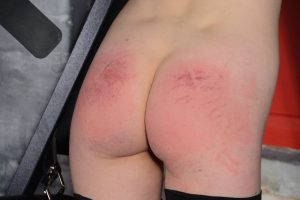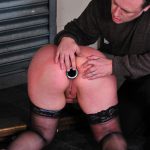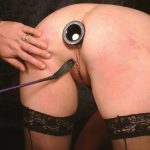Humans are constantly shedding their skin. Unlike creatures that shed a complete layer all at once, we shed our outermost layer as individual cells. Like a fine dust constantly being emitted from the body. Also, the body secretes oil through the skin to keep it moist. Fingerprints are made from this oil. In addition, perspiration leaves salts and other deposits on the surface of the skin. Spanking abrades away the dead skin cells from the surface, and wipes off the oils, perspiration and salts in a vigorous manner. Implements get dirty very quickly.

The dirt may not be visible at first, but it is there and continues to accumulate. And it is especially hard to see on dark colored implements. Spanking with a dirty toy is like wearing dirty underwear. And if the same implement is used with multiple partners, it is like sharing that dirty underwear. Because spanking abrades the skin, deposits from one person can be transferred to another. Even if the implement is used with only one partner, deposits from that person’s bottom and from the hand of the person holding the toy continue to grow.
- Whatever the implement, for good hygiene and healthy play it should be washable. This includes washing the hands before and after play.
Dirt accumulations build in the grains of wood, and in the pores of leather. If the wood is finished with varnish or lacquer, then cleaning and disinfecting will not ruin it – the grain is sealed. Wash it with a solution of mild dishwashing detergent, dry, then spray with a disinfectant such as Lysol. Unfinished wood is not easily cleaned. Water raises the grain, and may actually cause the deposits to be absorbed into the wood. Also, the wood may warp or crack, or become easier to crack.
- Finished wood is washable, unfinished wood is not. Choose wood implements that are finished, or finish them yourself.

Wood implements can crack or split. Because the bottom is spherical, there is no particular grain orientation that prevents cracking. Grain orientation lengthwise is the most robust, but will not prevent it entirely. And certain woods such as ash are less prone to cracking than pine. Still denser woods may resist cracking or splitting, but quickly become too heavy to make good toys.
- Wooden paddles should be medium density wood with lengthwise grain. It should be thick enough to resist cracking, but not more than 1/2 inch or it becomes too heavy for play.
It is better to have the wood implement break entirely than have a hidden crack. Cracks can pinch causing cuts, and leave splinters that are hard to remove and can become infected. Any wood toy should be examined carefully before use. And if an impact sounds different than the previous one, immediately check it. If cracked, immediately check the partner’s bottom for splinters or cuts and take appropriate action. Cracked implements should be discarded – do not try to fix them. They will crack again in another spot, with the same resulting dangers.
- Wooden paddles can crack during play. Listen to their sound, and take immediate action to protect the bottom if they do. And discard it – it is a weak and dangerous toy that cannot be safely repaired.
Roughly 80% of bottoms prefer the feel of leather over wood. Because it can flex it contours itself to the bottom, and has a less harsh feel. And it has good sound, which is an important part of the play. But it is the most difficult to clean, and some leathers cannot be cleaned at all. There are cleaning instructions listed in another section – go here to read them.
- Leather is preferred by 80% of bottoms. The implement collection should reflect this proportion.
Leather can crack, just like wood. There is minimal risk of injury, but the implement can rarely be salvaged. Leather cracks for a number of reasons. If the leather is dyed, coloring agents fill the pores of the leather and make it brittle, as do the solvents used in the dying process. Continued flexing results in cracking. Most leathers are coated with wax to give them a sheen. This also seals the pores against water, but leather needs to absorb moisture from the air to remain supple. As a result, the leather dries out and becomes brittle. Again, flexing leads to cracking. The dirt accumulation builds up in the cracks, and becomes absorbed in the exposed pores of the leather. It is extremely difficult to clean, and disinfecting can lead to further cracking. Once the leather toy develops cracks, it should be discarded.
- Leather that is dyed a color, or waxed to give it sheen will crack. Dirt gathers in the cracks, and it should be discarded.
Most leather will crack if it gets wet because it shrinks when it dries out. This is a result of the tanning process used. Chromic acid tanned leather is the most common type because the process is very fast and inexpensive. About 95% of all leather is tanned using this process. A quick wipe with a damp cloth is all the moisture it can tolerate, otherwise it can be damaged and will crack prematurely. Natural vegetable tanned leather is the exception. It is more expensive because the tanning process takes many times longer. Washing will not harm this type of leather – it can be soaked in water and will not crack as a result. This type of leather is used for carving – saddles, purses, etc. But carving breaks the skin, and allow dirt to accumulate in the pores underneath. It can be washed, but the dirt is still difficult to remove from the exposed pores.
- The best implements are made from undyed, uncoated, and uncarved vegetable tanned leather. They can be washed, and improve with use.
Leather paddles and straps should be stiff enough to prevent wrapping – the end wraps around the bottom and leaves a mark or cut on the side of the hip. The end of the strap or paddle should contact the curvature of the bottom, not wrap around it. In an OTK position, the opposite hip is not easily visible, so the top should check regularly to make sure these is no wrapping. If this occurs, either the implement is too long, too flexible, or not right for the position. Some leather paddles have flat spring steel stays inside. This adds rigidity to leather that is too thin and soft on its own. This helps to prevent wrapping, but friction against the steel wears the leather out from the inside, and leads to cracking around the edges of the insert.
- The rule regarding toys is better too short than too long, and better too stiff than too flexible. Wrapping is poor play.
Different toy shapes provide different sensations. Implements having a small contact surface area are generally “stingy,” while those having a larger surface area are “thuddy.” And different shapes (e.g. an oval paddle versus a straight strap) apply impact over different areas of the bottom to vary the sensation. Some paddles have rabbit fur on one side. The natural oils in the fur dry out, resulting in shedding, and using the fur side for impact accelerates the shedding. That side is intended for rubbing during warmup and cooldown.
- Shape and surface area determine the toy’s sensation. Small impact surface areas are stingy, and large is thuddy.

There are a variety of leather treatments available. Some include silicone, and many include Neets Foot oil. These treatments, including waxes, are meant for shoes, boots, purses, saddles, baseball gloves, etc. Their purpose is to soften or waterproof leather. These treatments should never be used on spanking implements. They can trap dirt and bacteria, and some people may have allergic reactions.
- Do not wax, or apply oil or silicone treatments to leather spanking implements.
Some toys are made from rubber. It is flexible and easily cleaned. And it is much denser than leather, and very harsh. Very few bottoms choose rubber. It should not be viewed as a leather substitute, but rather as a different type of toy. And implements should never be made from latex rubber. Some people are very allergic to latex, and can have a severe allergic reaction.
- Rubber is not a leather substitute, and implements should never be made from latex rubber.
Plastic implements are easy to clean. Some plastics are brittle (styrenes) and some bendable (ethylenes), and all are more dense than wood. Riot control whips (sjamboks) are made from ethylenes, and can be very severe and easily leave marks. Even the softest plastics are only semi-flexible when made thick enough to become an effective toy. Paddles made from acrylics or styrenes can be made half the thickness of wood with comparable strength and weight. And they can crack as well, so the same cautions should be observed. Implements made from these materials are especially prone to cracking when exposed to citrus based cleaning agents. Fissures form on the surface, and the implement can shatter with disastrous results. Use only mild dishwashing detergent and disinfectant, and inspect before use.
- Plastic paddles should be no more than 1/4 inch thick. Never wash them with citrus based cleaners.
Canes are a love/hate implement – the bottom either loves it or hates it. Bottoms who prefer sting over thud generally find the sensation pleasing. Canes are generally made from rattan – a type of grass. Rattan is made up of many tiny hollow tubes, which gives it flexibility. When rattan breaks, it rarely splinters. And rattan canes generally break at the far end where it tries to wrap around the bottom too quickly. This keeps any splintering away from the point of impact. Finished, or unfinished, rattan canes can be easily washed with mild dishwashing detergent, rinsed, and disinfected. When wet, they are easily bent and should be allowed to dry straight. If the finish begins to flake, either from washing or use, lightly sand the area using 320 grit sandpaper (or finer). It does not need to be refinished.
Bamboo (another type of grass) can crack anywhere, and leaves very sharp and stiff splinters. Bamboo canes, back-scratchers, spoons, etc. are poor choices for implements because of this risk.
- Use only rattan, or hollow plastic canes. Never use bamboo for any kind of toy.
Before using a cane, practice is required to prevent injury. The traditional practice method is to strike a 5 pound paper sack of flour. The goal is to leave a series of evenly spaced creases in the sack without breaking it. A pillow is often substituted, but this is not recommended as there is no way to accurately gauge the intensity of the stroke.
If the cane breaks and is still a usable length, carve then sand to round the tip. A usable length is about 8 inches minimum from the end of the hand to the edge of the bottom, and the tip extending past the other edge of the bottom by about 4 inches. Canes are severe – all the impact is placed on a small skin area. And canes mark easily, leaving a double line spaced by the width of the cane. The position used should be standing upright, or with a small bend at the hips so the skin is not drawn tight. Never impact with the tip, and avoid striking the same spot more than once. Canes have an initial sting at impact, followed by a wave of warmth. Allow about 30 seconds between strokes for the full effect.
- Be cautious of position and intensity when a cane is used, and allow 30 seconds between strokes.
Crops are similar to canes, except the “popper” at the end is used for impact. All of the energy is applied to this small area, so similar cautions should be observed. The strokes can come more quickly, depending on the size of the popper. Crops with small poppers are used for horseback riding – horses have thick skin covered with hair. Only crops with large poppers should be used for play. Cleaning is done depending on the material – the grip, the shank, and the popper may be plastic, leather, or some combination. Follow the appropriate instructions for each material presented above.
- The shorter the crop, the more flexible it should be. The popper at the end is the only area used to strike with, and larger is better.
Dressage whips are similar to crops, except a strand is attached instead of a popper. And they are cleaned the same way – depending on materials used. The technique used is to rapidly swing back and forth horizontally, using only the tip of the strand to make contact. The effect is similar to a series of bee stings. And just like a crop, this implement should never be used like a cane. It is too thin, and lacks the flexibility.
- Never use a crop or dressage like a cane. They are different toys for different uses.
Floggers offer the widest variety of sensations of any single toy. They can be made of leather, deerskin, suede, rope, cloth, or nearly any material. They come in a variety of lengths, weights, and number of falls. The number of falls is normally 32 or 40, with ends cut square, round, or at an angle. Floggers are best used vertically, not horizontally like a paddle or cane. The bottom can either be standing, kneeling or lying down.
The technique is for the top to draw figure eights with the arm, alternating palm up and palm down for each half of the eight. The weight and speed of the falls are dropped onto the target, not swung into it. The top can also twirl the flogger, impacting only with the tips. The sensation varies with the intensity. From massage-like thuddy to very stingy. A flogger having fewer and narrower falls is called a martinet. It can be used either vertically or horizontally, but vertical is still preferred. It is generally light with much more sting than a flogger.
- Floggers should be used vertically, not horizontally. The falls should be wide and soft for a variety of sensations. A heavier flogger having more falls is better.
Single tails can be stock whips, saddle whips, signal whips, bull whips, etc. They can be made from kangaroo skin (the strongest hide), cow hide, or many other leathers. There are special dressings exclusively manufactured for whips, that must be applied per the manufacturers directions (either from handle to tip or vice versa). Use only the recommended treatments to preserve the layers underneath the outer layers.
These implements can be dangerous to both the bottom and the top, and never used without proper instruction by an expert. The basic technique is for the top to visualize standing on railroad tracks, and keep the arm and whip outside the rails. Then “toss” the tip underhanded at the target. The hand is kept palm down, and the arm never rises above level. Only the attached tip (either a woven silk or kevlar string) strikes the target. The whip returns along the angle of the arm and falls harmlessly back outside the railroad tracks.
Birching uses bundles of either birch branches or firethorn branches. They are cut off, pickled in a brine solution and bundled with string to form a handle. They are applied as light horizontal taps, and can be exceptionally severe with minimal impact. There are no thorns, and the appearance of a bundle of twigs is deceptive. And the sensation can last for days. This technique should only be applied by an expert.
- Do not experiment with unknown and unpracticed implements on a partner. Or be the subject of an experiment. That is no way to play.
Metal implements are not for impact play. Spatulas, and other objects have a single purpose – cooling. Kept in the freezer, and applied to a warmed bottom, they cool and reduce potential swelling. That is their only use.
Skin creams or oils can be applied to the bottom after play for a cooling and soothing effect. Some offer more comfort than others. And some can rekindle the burning rather than the desired cooling effect. Unless the effect is known, a clean towel moistened with lukewarm water is the recommended approach.

















